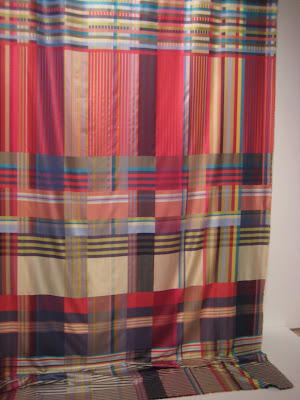*Dorte Behn
*Christopher Farr
*Ptolemy Mann
*Fiona Mathison
*Laura Thomas
*Wallace Sewell
All of whom are contemporary artists and designers influenced significantly by Albers. Her incredible skill and devotion to weaving is evident in her impact on generations of designers and craftspeople. It is interesting to note that not all works have a direct aesthetic relationship but some designers have work which has been profoundly affected through Albers's technical knowledge or approach to design.
I am currently really enjoying my weaving and it has even crossed my mind that this may be my specialism! However I was chatting to the girls at uni and some raised the issue that weaving would be really restrictive and not allow for much freedom. 'Influenced by' totally dispels this myth. The first work as you enter the room is an enormous woven linen and plastic construction by Dorte Behn. This artist, similarly to Albers, considers weaving as a method of construction next to architecture.

Laura Thomas's work equally questions what is a textile and evokes significant curiosity.

I particularly like her acrylic vessels which encapsulate threads. They play with the idea of the horizon line and a visual vanishing point. What makes them particularly stunning is the juxtaposition of the hard edged acrylic and the delicate unwoven threads. Looking at her blog, I notice she has worked extensively with this idea-
http://laurathomaswoventextiles.blogspot.com/

'Chromoscope', 2008
Cotton and silk encapsulated in acrylic.

'Better than Grey' exhibition at Bury St Edmunds Art Gallery.

'Harmony', 2009.
Her other exhibit is a woven canvas consisting of triaxial structures, oblique angles and triangles all of which challenge the prescribed boundaries of the loom. It has also succeeded in creating a new visual rhythm of geometry, repeat pattern and colour. I'm especially fond of the complimentary colours used, acid yellow, deep aubergines, graphite and dark chocolate, all of which provide a stark yet harmonious contrast.

The woven textiles of Wallace Sewell also explore colour and abstract composition. In a way, the warp is used like a blank canvas. This method reminds me of my visit to the Dovecot contemporary tapestry studios in Edinburgh which takes commissions to turn artists paintings and drawings into tapestries.
http://www.dovecotstudios.com/index.aspx
Once again the work of company Wallace Sewell pushes the boundaries of traditional weaving through juxtaposing yarns and structured and with considered investigation of colour proportion. The designers say that there work develops intuitively rather than following fashion trends.

'Sampler', 2010.
Fiona Mathison's interactive installation was so original and memorable. As I wondered through the vertical constructions looking at the various mirrors bordered with tapestry weaving I was infact acting like a thread myself, my path winding an invisible fabric around the vertical warp. A very intimate experience and such an innovative idea challenging what is a woven textile.

'Sanctums'

Ptolemy Mann was directly influenced by Albers's early wall pieces from 1925 and are in essence architectural 'towers of cloth'.

'Three Pieces to Dress a Wall (after Albers)', 2010.
Albers herslef remains highly influential in the textiles world. Becoming the first textile artist to have a solo exhibition at MOMA New York proves the mastery of her innovative, abstract textiles. She has two publications-
*On designing 1959
*On weaving 1965
Albers herself drew inspiration from the skill and poetry of artists ranging from anonymous pre-columbian weavers to Paul Klee. Here are a few examples of her weaves, drawing and screenprints which she decided to pursue further later in life.

Wallcovering material
Cotton, raffia and chenille

Code, 1962
Pictorial weaving
Cotton, hemp, metallic thread

Haiku, 1961
Pictorial weaving
Cotton, hemp, metallic thread

Drawing for a Rug II, 1959
Gouache on paper

The other smaller exhibition, 'Elemental' was also very inspirational. It focused on artists using the natural characteristics of materials that come from the earth to reveal varied and fascinating identities. I was personally a fan of-
Magie Holingworth's recycled paper vessels

Dionne Swifts subtle printing

Wycliffe's tonal wooden wall hangings (these remind me of colour proportion wrappings)


No comments:
Post a Comment